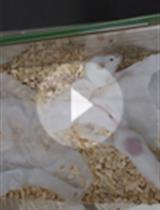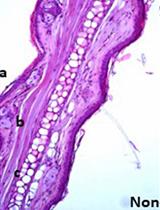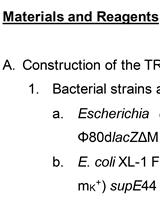- Submit a Protocol
- Receive Our Alerts
- EN
- EN - English
- CN - 中文
- Protocols
- Articles and Issues
- For Authors
- About
- Become a Reviewer
- EN - English
- CN - 中文
- Home
- Protocols
- Articles and Issues
- For Authors
- About
- Become a Reviewer
Virulence Studies of Clostridium difficile
Published: Vol 3, Iss 24, Dec 20, 2013 DOI: 10.21769/BioProtoc.1002 Views: 7878
Reviewed by: Anonymous reviewer(s)

Protocol Collections
Comprehensive collections of detailed, peer-reviewed protocols focusing on specific topics
Related protocols

Visualizing Hypoxia in a Murine Model of Candida albicans Infection Using in vivo Biofluorencence
José Pedro Lopes and Constantin F. Urban
Aug 5, 2019 3920 Views

RNA Extraction from Ears and Draining Lymph Nodes of Mice Infected with Leishmania amazonensis
Emilie Giraud and Evie Melanitou
Jun 5, 2020 4004 Views

TetR Regulated in vivo Repression Technology to Identify Conditional Gene Silencing in Genetically Engineerable Bacteria Using Vibrio cholerae Murine Infections as Model System
Franz G. Zingl [...] Stefan Schild
Oct 5, 2020 2114 Views
Abstract
Clostridium difficile (a Gram-positive, spore-forming, strict anaerobe) can colonize antibiotic-treated hosts (McFarland, 2008). Antibiotics alter the composition of the normal, benign microbial flora which leads to loss of colonization resistance (Wilson and Perini, 1988; Antonopoulos et al., 2009). C. difficile spores germinate to actively growing bacteria which secrete toxins that damage the colonic epithelium (Voth and Ballard, 2005). The use of animal models of C. difficile disease have allowed the identification of mechanisms of colonization and virulence factors (Lyras et al., 2009; Kuehne et al., 2010; Francis et al., 2013; Aubry et al., 2012; Carter et al., 2011). This protocol describes virulence studies of C. difficile in the hamster model of C. difficile infection (Bartlett et al., 1978; Sambol et al., 2001).
Keywords: Clostridium difficileMaterials and Reagents
- Institutional Animal Care and Use Committee (IACUC)-approved animal use protocol
- C. difficile spores
- Female Syrian golden hamsters (80 g–120 g)
- Clindamycin Injection, USP (150 mg/ml) (Hospira, catalog number: 0409-4052 )
- Dulbecco’s Modified Eagle Medium (DMEM)
Equipment
- Animal feeding needles (gavage needles)
- 1 ml syringe
- Dedicated BSL2 animal facility
- Scale
Procedure
- Weigh each hamster.
- Gavage 100 μl clindamycin to each hamster (30 mg clindamycin / kg body weight).
Note: Dilute the stock clindamycin to the appropriate concentration using DMEM.
- After 5 days, gavage 100 μl C. difficile spores.
Notes:
- Depending on the strain of C. difficile used, the infectious dose can vary. However, in several strains, inoculation with approximately 100 spores will result in lethal disease.
- There are several methods to ensure reproducible infectious doses [e.g. suspending spores in phosphate buffered saline (PBS)]. Our laboratory uses Teflon-coated tubes to reduce spore adherence. Other laboratories can get reproducible infectious doses in water.
- Depending on the strain of C. difficile used, the infectious dose can vary. However, in several strains, inoculation with approximately 100 spores will result in lethal disease.
- Closely monitor animals for signs of infection including: wet tail, poor fur coat, lethargy, loss of 15% body weight.
Note: Signs of disease are commonly observed in 2 – 4 days post infection. Be sure to closely monitor the animals for the above symptoms. Moribund animals can succumb to disease quickly.
- Humanly euthanize moribund animals, in accordance with your protocol that was approved by your Institutional Care and Animal Use Committee (IACUC). Score the time required to reach a moribund state.
Acknowledgments
We would like to thank Charlotte Allen and Ritu Shrestha for aiding in the development of this protocol. This protocol is based upon previously published C. difficile virulence studies by Sambol et al. (2001), wherein the authors analyzed the infection of hamsters by epidemiologically important C. difficile isolates. This work was supported by the American Heart Association National Scientist Development grant to JAS (No. 11SDG7160013). The funders had no role in study design, data collection and analysis, decision to publish, or preparation of the manuscript.
References
- Antonopoulos, D. A., Huse, S. M., Morrison, H. G., Schmidt, T. M., Sogin, M. L. and Young, V. B. (2009). Reproducible community dynamics of the gastrointestinal microbiota following antibiotic perturbation. Infect Immun 77(6): 2367-2375.
- Aubry, A., Hussack, G., Chen, W., KuoLee, R., Twine, S. M., Fulton, K. M., Foote, S., Carrillo, C. D., Tanha, J. and Logan, S. M. (2012). Modulation of toxin production by the flagellar regulon in Clostridium difficile. Infect Immun 80(10): 3521-3532.
- Bartlett, J. G., Chang, T. W., Moon, N. and Onderdonk, A. B. (1978). Antibiotic-induced lethal enterocolitis in hamsters: studies with eleven agents and evidence to support the pathogenic role of toxin-producing Clostridia. Am J Vet Res 39(9): 1525-1530.
- Carter, G. P., Douce, G. R., Govind, R., Howarth, P. M., Mackin, K. E., Spencer, J., Buckley, A. M., Antunes, A., Kotsanas, D., Jenkin, G. A., Dupuy, B., Rood, J. I. and Lyras, D. (2011). The anti-sigma factor TcdC modulates hypervirulence in an epidemic BI/NAP1/027 clinical isolate of Clostridium difficile. PLoS Pathog 7(10): e1002317.
- Francis, M. B., Allen, C. A., Shrestha, R. and Sorg, J. A. (2013). Bile acid recognition by the Clostridium difficile germinant receptor, CspC, is important for establishing infection. PLoS Pathog 9(5): e1003356.
- Kuehne, S. A., Cartman, S. T., Heap, J. T., Kelly, M. L., Cockayne, A. and Minton, N. P. (2010). The role of toxin A and toxin B in Clostridium difficile infection. Nature 467(7316): 711-713.
- Lyras, D., O'Connor, J. R., Howarth, P. M., Sambol, S. P., Carter, G. P., Phumoonna, T., Poon, R., Adams, V., Vedantam, G., Johnson, S., Gerding, D. N. and Rood, J. I. (2009). Toxin B is essential for virulence of Clostridium difficile. Nature 458(7242): 1176-1179.
- McFarland, L. V. (2008). Update on the changing epidemiology of Clostridium difficile-associated disease. Nat Clin Pract Gastroenterol Hepatol 5(1): 40-48.
- Sambol, S. P., Tang, J. K., Merrigan, M. M., Johnson, S. and Gerding, D. N. (2001). Infection of hamsters with epidemiologically important strains of Clostridium difficile. J Infect Dis 183(12): 1760-1766.
- Voth, D. E. and Ballard, J. D. (2005). Clostridium difficile toxins: mechanism of action and role in disease. Clin Microbiol Rev 18(2): 247-263.
- Wilson, K. H. and Perini, F. (1988). Role of competition for nutrients in suppression of Clostridium difficile by the colonic microflora. Infect Immun 56(10): 2610-2614.
Article Information
Copyright
© 2013 The Authors; exclusive licensee Bio-protocol LLC.
How to cite
Readers should cite both the Bio-protocol article and the original research article where this protocol was used:
- Francis, M. B. and Sorg, J. A. (2013). Virulence Studies of Clostridium difficile. Bio-protocol 3(24): e1002. DOI: 10.21769/BioProtoc.1002.
- Francis, M. B., Allen, C. A., Shrestha, R. and Sorg, J. A. (2013). Bile acid recognition by the Clostridium difficile germinant receptor, CspC, is important for establishing infection. PLoS Pathog 9(5): e1003356.
Category
Microbiology > Microbe-host interactions > In vivo model
Immunology > Host defense > General
Do you have any questions about this protocol?
Post your question to gather feedback from the community. We will also invite the authors of this article to respond.
Tips for asking effective questions
+ Description
Write a detailed description. Include all information that will help others answer your question including experimental processes, conditions, and relevant images.
Share
Bluesky
X
Copy link







